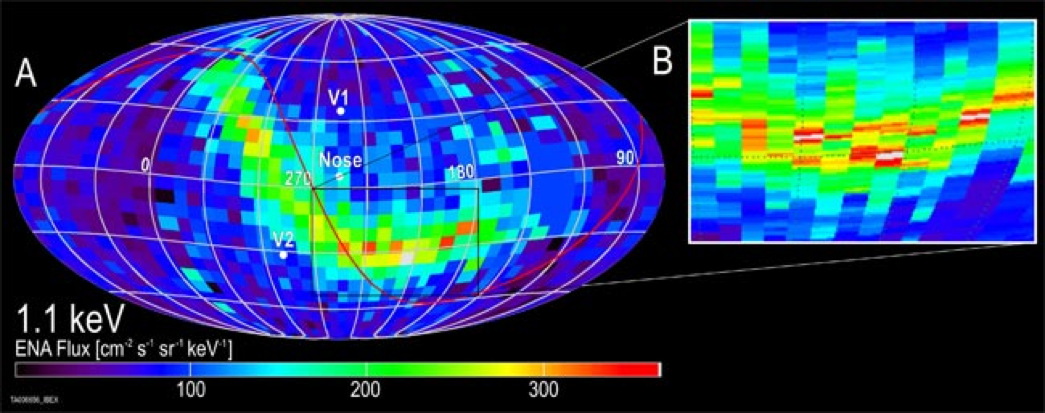Mysterious Ribbon at Edge of Solar System Explained

A mysterious ribbon spotted on the edge of the solar systemhas turned out to be a reflection of particles streaming off the sun,scientists have found.
The space ribbon? a long band of high-energy particle emissions ? was first noticed last yearby NASA's IBEX (InterstellarBoundary Explorer) spacecraft, which studies the boundary between our solarsystem and the rest of the galaxy. Scientists were mystified by it, calling thediscovery a "shocking result."
But now researchers think they?ve figured out the origin ofthe bizarre structure.
"We believe the ribbon is a reflection," saidJacob Heerikhuisen, a NASA heliophysics guest investigator from the Universityof Alabama in Huntsville. "It is where solar wind particles heading outinto interstellar space are reflected back into the solar system by a galacticmagnetic field."
The sun emits a stream of charged particles called the solarwind. These particles apparently travel out to the edgeof the solar system, where they encounter a strong magnetic field comingfrom the rest of the galaxy, that slingshots them back in the direction theycame from.
"This is an important finding," said Arik Posner,IBEX program scientist at NASA headquarters in Washington, D.C."Interstellar space just beyond the edge of the solar system is mostlyunexplored territory. Now we know, there could be a strong, well-organizedmagnetic field sitting right on our doorstep."
IBEX is an Earth-orbiting spacecraft that was launched inOctober 2008 to monitor incoming neutral atoms that originate billions of milesaway at the boundary between the solar system and the cold expanse of space.
Get the Space.com Newsletter
Breaking space news, the latest updates on rocket launches, skywatching events and more!
The ribbon IBEX saw is vast and stretches almost all the wayacross the sky, suggesting that the magnetic field behind it must be equally huge.The structure emits no light, but rather sends out these energetic neutralparticles that IBEX then captures.
"If this mechanism is correct ? and not everyone agrees? then the shape of the ribbon is telling us a lot about the orientation of themagnetic field in our corner of the Milky Way galaxy," Heerikhuisen said.
The solar system is passing through a region of the MilkyWay filled with cosmic rays and interstellar clouds. The magnetic field of ourown sun, inflated by the solar wind into a bubble called the heliosphere,substantially protects us from these things. However, the bubble itself isvulnerable to external fields. A strong magnetic field just outside the solarsystem could press against the heliosphere and interact with it in unknownways.
"IBEX will monitor the ribbon closely in the months andyears ahead," Posner said. "We could see the shape of the ribbonchange ? and that would show us how we are interacting with the galaxybeyond."
The researchers reported their findings in the Jan. 10th issueof the Astrophysical Journal Letters.
- Video - NASA's IBEX: Exploring the Solar System's Edge
- Images - Sun Storms
- Solar System Images From the Voyager Probe
Join our Space Forums to keep talking space on the latest missions, night sky and more! And if you have a news tip, correction or comment, let us know at: community@space.com.

Space.com is the premier source of space exploration, innovation and astronomy news, chronicling (and celebrating) humanity's ongoing expansion across the final frontier. Originally founded in 1999, Space.com is, and always has been, the passion of writers and editors who are space fans and also trained journalists. Our current news team consists of Editor-in-Chief Tariq Malik; Editor Hanneke Weitering, Senior Space Writer Mike Wall; Senior Writer Meghan Bartels; Senior Writer Chelsea Gohd, Senior Writer Tereza Pultarova and Staff Writer Alexander Cox, focusing on e-commerce. Senior Producer Steve Spaleta oversees our space videos, with Diana Whitcroft as our Social Media Editor.









